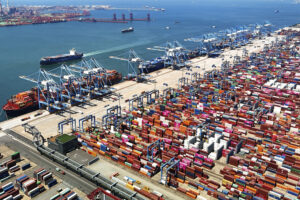China’s Exports Exceed Expectations in June, Imports Fall Short
In a recent report released by Chinese customs, it was revealed that China’s exports for the month of June surpassed expectations, growing by 8.6% compared to the same time last year, reaching $307.8 billion. This figure exceeded initial estimates of 7.4% to 8% growth. However, imports fell short of expectations, decreasing by 2.3% to $208.8 billion.
The trade surplus for China widened to $99 billion in June, up from $82.6 billion in May, driven by the strong performance of exports. These positive export numbers come at a time when China is facing heightened trade tensions with the U.S. and Europe, both of which have increased tariffs on Chinese-made electric cars.
Despite the challenges posed by tariffs, Zichun Huang of Capital Economics remains optimistic about China’s export outlook. She noted that while tariffs may have some impact, they primarily target a small portion of Chinese exports. Huang believes that trade rerouting and exchange rate adjustments can help mitigate these effects, allowing exports to continue supporting economic growth in the near term.
Looking ahead, Huang anticipates a rebound in import volumes, fueled by increased infrastructure spending as a result of recent government bond issuances. This is expected to stimulate demand for industrial commodities, providing a further boost to China’s economy.
In terms of export destinations, the Association of Southeast Asian Nations (ASEAN) countries remain the largest market for Chinese products, with exports growing by 10.7% year-on-year in the first half of the year. Notably, China exported $49.8 billion worth of goods to ASEAN nations in June.
While exports to the U.S. saw modest growth of 1.5% in the January to June period, shipments to the European Union declined by 2.6%. Key export categories for China this year include steel, automobiles, home appliances, and ships, with significant growth seen in these sectors.
However, challenges persist for China, as it faces accusations of overproducing and flooding global markets with cheap electric vehicles. The U.S. and EU have imposed tariffs on Chinese EVs, raising concerns about reduced exports and weakening domestic demand for these products.
Amidst these challenges, China’s manufacturing sector has shown stagnant growth, with the official purchasing managers index remaining unchanged at 49.5 in June. Economists point to weaker global demand, inflation concerns prompting central bank rate hikes, and a slowdown in the property sector as key factors weighing on China’s economic recovery.
To achieve its target of around 5% economic growth this year, China may need to implement additional policy support measures, according to experts. As the country navigates through these challenges, monitoring developments in trade relations and economic indicators will be crucial for investors and policymakers alike. Stay informed with Extreme Investor Network for the latest updates and insights on China’s financial landscape.

